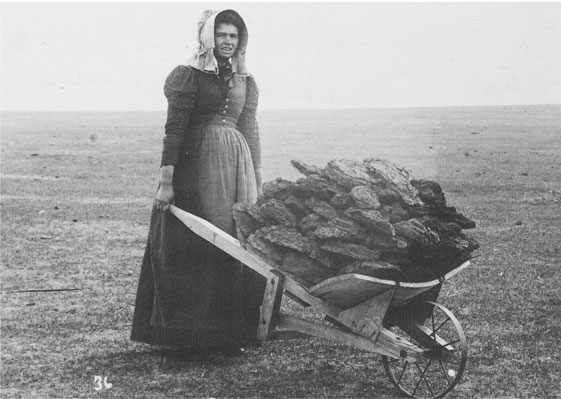Women Homesteaders
The women of the family were responsible for making homesteads more bearable. Mothers and daughters were in charge of household duties, cooking the meals, canning fruits and vegetables, and washing and ironing clothing. Despite the drudgery of this work, women contributed significantly to the economic well-being of the family by occasionally taking in boarders and selling milk, butter, and eggs.
In addition, a surprisingly large number of single women staked out homestead claims by themselves. Some were young, unmarried women seeking, like their male counterparts, economic opportunity. Others were widows attempting to take care of their children after their husband’s death. One such widow, Anne Furnberg, settled a homestead in the Dakota Territory in 1871. Born in Norway, she had lived with her husband and son in Minnesota. After her husband’s death, the thirty-four-year-old Furnberg moved with her son near Fargo and eventually settled on eighty acres of land. She farmed, raised chickens and a cow, and sold butter and eggs in town. The majority of women who settled in the Dakotas were between the ages of twenty-one and twenty-five, had never been married, and were native-born children of immigrant parents. A sample of nine counties in the Dakotas shows that more than 4,400 women became landowners. Nora Pfundheler, a single woman, explained her motivation: “Well I was 21 and had no prospects of doing anything. The land was there, so I took it.”

Once families settled in and towns began to develop, women, married and single, directed some of their energies to moral reform and extending democracy on the frontier. Because of loneliness and grueling work, some men turned to alcohol for relief. Law enforcement in newly established communities was often no match for the saloons that catered to a raucous and drunken crowd. In their roles as wives, mothers, and sisters, many women tried to remove the source of alcohol-induced violence that disrupted both family relationships and public decorum. In Kansas in the late 1870s, women flocked to the state’s Woman’s Christian Temperance Union, founded by Amanda M. Way. Although they did not yet have the vote, in 1880 these women vigorously campaigned for a constitutional amendment that banned the sale of liquor.
Temperance women also threw their weight behind the issue of women’s suffrage. In 1884 Kansas women established the statewide Equal Suffrage Association, which delivered to the state legislature a petition with seven thousand signatures in support of women’s suffrage. Their attempt failed, but in 1887 women won the right to vote and run for office in all Kansas municipal elections. Julia Robinson, who campaigned for women’s suffrage in Kansas, recalled the positive role that some men played: “My father had always said his family of girls had just as much right to help the government as if we were boys, and mother and he had always taught us to expect Woman Suffrage in our day.” Kansas did not grant equal voting rights in state and national elections until 1912, but women obtained full suffrage before then in many western states.
Exploring American HistoriesPrinted Page 503
Exploring American Histories Value EditionPrinted Page 372
Chapter Timeline